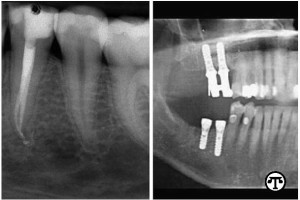While the ultimate recommendation of what to do with a tooth that needs repair is subject to a consultation with your NYC endodontist, it is important for everyone to understand what the options are and what the outcomes will be between endodontic treatments and implants.
How endodontic treatments differ from dental implants
Root canals are endodontic treatments that involve a sequence of treatments used to treat the infected pulp of a tooth. Root canals eliminate infection and protect the treated tooth from further infection. The root canals of a tooth are the hollows within the root of a tooth that house the nerves, blood vessels, and other tissues, altogether called pulp.

A dental implant requires surgery to implant a dental prosthesis, so that it interfaces successfully with the jawbone or skull. In the implant, materials like titanium are used to form a bond with bone. This process is called osseointegration, and next (after a period of healing) a dental prosthesis is added. There are several factors involved with this process: the health of the bone and gums and the stress that will be place on the tooth implanted. The resulting implant may be either fixed or removable, depending on the patient’s circumstances.
Which is the better choice?
Last year, NYC Endodontists Mian K. Iqbal, DMD, MS and Syngcuk Kim, DDS, PhD undertook a scholarly systematic review of all the studies on that question that had been published. Their paper weighed all the study results to determine what the differences in outcomes of endodontically restored teeth are when compared with (single tooth) restorations that were supported by implants.
Their results showed that both methods of tooth restoration lasted well during the study periods (from 5 to 8 years). In situations where either method is viable, there were few studies to suggest which was the better approach. In creating a treatment plan, the NYC endodontist and the patient need to look at a wide variety of factors before choosing which method of restoration is best for the patient. Saving a tooth if at all possible, however is the preferred method of Fifth Avenue Endodontics
Endodontist NYC
Dr. Kim and Dr. Iofin believe in treating each patient with the therapy that is best for the patient. When you have tooth pain in New York City, there is no better place to go than to see them at Fifth Avenue Endodontics. You will be pain free in no time.


